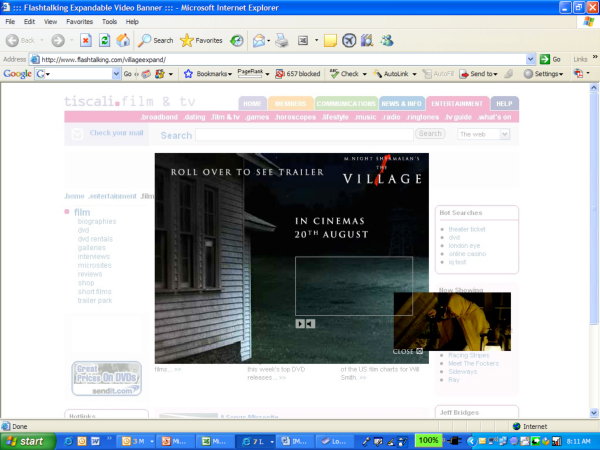What’s New in Banner Advertising? Video, Animation, Interactivity
Online ad spending in the U.S. is sizzling hot, predicted to grow 28.2% in 2007, or seven times faster than ad spending in other media, according to ZenithOptimedia. In the first three quarters of 2006, online ad revenues represented $12.2 billion, said PricewaterhouseCoopers. Wow.
Beyond the mere U.S., ZenithOptimedia projects that the Internet’s share of worldwide total ad spending will grow from 5.8% in 2006 to 8.6% in 2009. Television, radio and outdoor are expected to remain flat. The Internet’s growth will be assisted by declines in newspaper and magazine advertising.
The two large categories that make up Internet ad spending are paid search (SEM) and banner advertising. We all know how huge and fast-growing SEM is. But the banner ad category is holding its own, expected to grow to $13.2 billion worldwide by 2009.
Now that broadband is used by 50 million U.S. households, online advertising has moved way beyond “billboards in cyberspace,†which is a fair description of the early ad styles. Today, advertisers have the technology and the bandwidth to be very creative in capturing visitor attention, engaging their interest, and motivating them to act.
Here are some of the newest techniques being used in banner advertising:
Expandable ad windows
One exciting new ad format is the banner that expands across the webpage when the visitor mouses over it. Website publishers appreciate this technique because it is highly interactive and engaging, but it also keeps the visitor at the original site, rather than “hijacking†the visitor to another page, never to return. Once the banner unit is expanded, the advertiser can include all kinds of involvement devices, like video, games, surveys, sign-up forms, and selling copy.

An expandable banner ad for a new movie called “Village†includes a clip from the movie trailer.
Running a Live Event Inside a Banner Ad
Not only can you show videos inside banners, marketers can even set up real-time live events that take place within the banner environment. In April 2006, The New York Times’s website ran a live webcast within a banner ad for Cisco Systems, the large Internet technology company. The webcast featured a 15-minute speech by Ron Ricci, Cicso’s vice president of corporate positioning, and then ran about 11 minutes of live Q&A with viewers.
Unlike the typical webcast, which is archived for on-demand streaming, this Cisco ad operated more like traditional programmed television, meaning, a live event. The Times promoted the event heavily, running 1.3 million ad impressions, beginning five days in advance. Ad viewers were invited to enter their email addresses or cell phone numbers to receive reminders about the event.

Sign-up form within the banner announces the Cisco live event.
Pay-per-play video ads
Google AdWords recently launched a new ad medium to its portfolio:
Pay-per-play video ads.Here’s how it works: A static image is displayed on the page,inviting visitors to click. When they hit the “play†button, the video begins,delivered from Google’s servers.
After viewing the video clip, the user can click on the advertiser’s URL at the bottom of the ad, and visit the advertiser’s website. Interestingly, this is when the advertiser is charged the fee pre-determined by his/her bid. There is no charge to the advertiser when the visitors merely watch the clip.
With this new medium, advertisers get the famous keyword-based targeting capability, and limitedfinancial risk, along with a stimulating sound-and-motion creative platform. Advertisers also have the option of targeting based on the demographics, product category or site, and pay on a cost-per-thousand basis.
Google also has added one extra-friendly angle to its bidding system: To reduce the chance thata marketer is paying too much, the winning bid is automatically dropped down to the level of one penny above the next advertiser’s bid. Google hopes that this service will make video ads accessible even to marketers with very small ad budgets.

Google’s new pay-per-click video ad format makes video ads available to all kinds of marketers.
In-text advertising
The creative possibilities for banner ads seem endless. But on the most popular websites, banner ad inventory is beginning to sell out. So publishers are aggressively experimenting with new ad opportunities, one of them being “in-text†ads that appear when the mouse is moved over key words in news or other website copy.
To distinguish the ads from regular text links, publishers often use a double underline. For example, in an article about clothing, a text ad may appear when the visitor mouse over terms like “sweater†or “jeans.â€
This ad unit is not without controversy, however. When the ads are embedded in news articles, one of the most vociferous critics is the journalists themselves. Forbes, com, for example, tested the use of in-text ads in 2004, but changed its mind after reporters complained that the ads were intruding on their articles.


